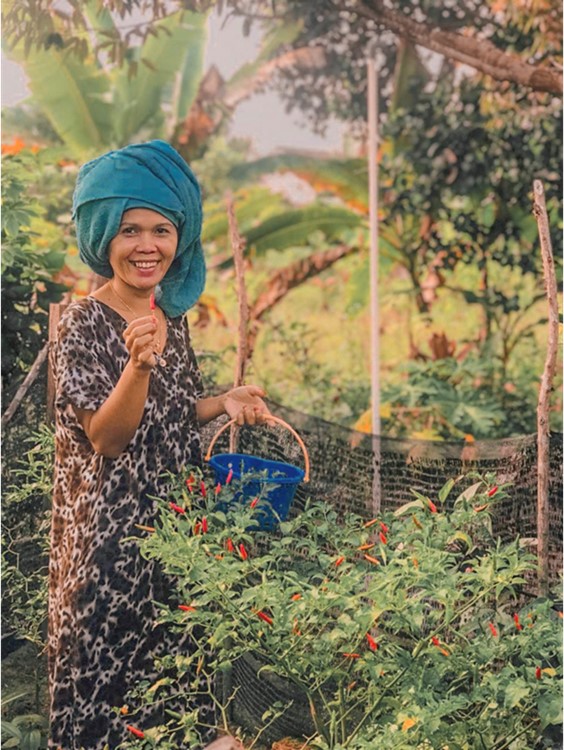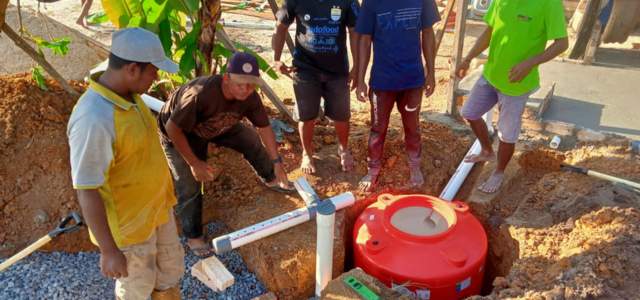This series was designed as a learning exchange and a follow-up to the actions registered in the Integrated Water Security Open Program (IWSOP) platform.
The Integrated Water Security Open Program (IWSOP) was launched on 14 September 2022 during the Regional Workshop. To date, 30 actions have been registered, with spatial distribution across Southeast Asia Countries such as Indonesia, Malaysia, Philippines, and Viet Nam. IWSOP is a multi-stakeholder program that aims to mobilize and synergize actions to achieve water security goals by implementing IWRM principles, the Sendai Framework, and the Source-to-Sea approach by providing a space for alignment of actions.
As a first follow-up to the IWSOP action’s registration, the theme of Water and Sanitation Hygiene was chosen, featuring our Partner Safe Water Gardens’ initiative, located in Bintan Island, Indonesia.
The story of Safe Water Gardens began from Mr. Marc van Loo, the owner of a Resort in Bintan Island, Loola Eco Resort. The story sadly started with the death of a baby, the daughter of one of his employers due to bad sanitation. This event was the underlying motivation to establish Safe Water Gardens (SWG).
The SWG system is modelled on a concept developed after Aceh tsunami in December 2004. The model suits individual household and community centres like rural schools. The system consists of 4 main components: 1) a closed plastic 500 ltr tank (the liquefier) connected to the toilet & shower (grey water sources), 2) a leach field garden (2 x 3 x 0.5 m), 3) and a system of pipes connecting the part. For this system to work, 4) a separate kitchen sink with a separate leach field is needed to avoid oily kitchen wastewater flow into the liquefier, thus would not allow worms and maggots in the tank that can seize up the system.
Picture 1. Components of SWG System
From a Model Village Program (MVP) to a Global Scale Up
The UN’s SDGs targeted a universal access to Water and sanitation by 2030, billions of People Will lack of access to these basic services unless quadruples the effort. Thus, combining effort allowing different sanitation systems and financial options is fundamental.
In 2019, the SWG system received approval from the Ministry of Public Works and Housing as an option for having improved and safe sanitation, fit for use for up to 10 households (per SWG). The SWGs also collaborate with the Indonesia research institution from Gajah Mada University, UMRAH University to ensure the effectiveness and sustainability of the system ready for large-scale projects.
One of SWG system required an investment of less than $ 250/household (if families share) and can be installed in 1 day. The initial system that currently present in several locations in Bintan Island had been installed for about 7 years and not required desludging (maintenance-free). A family can use the SWG garden to grow their own chilli and then move to micro-farming. This sanitation system is 3-6 times cheaper than alternatives and already proven in catalysing micro-farming and micro businesses.
Picture 2. SWG system catalyzing micro farming, help to improve livelihood

To extend the benefits of the program, Safe Water Garden aims bigger by incorporating several WASH components. The SWG project in Bintan Island has broadened its program from safe sanitation to include water and hygiene (WASH) and micro-farming. Furthermore, the project also tested the Safe Water Gardens system for different characteristics of the house based on its location. From an inland/ dry location (far from a water body) to a typical seashore household or next to a mangrove river. Thus, in the long run wished for sustainable villages. Bintan project is expected to be the first Model Village Program (MVP) and has received political support from the governor of Riau Island Province. Currently, 58 households in the three villages of Busung, Kuala Sempang, and Pengujan became MVPs. The project includes the installation of 48 SWG units, five water reservoirs, 51 kitchen sinks, 46 toilets, and 58 Nazava filters. Two hundred and sixteen residents from 58 heads of households have been positively affected by this program, as well as the emergence of 13 new micro businesses. The program is a collaboration between Water Stewardship Indonesia, Global Water Partnership Southeast Asia, Safe Water Gardens, Gajah Mada University, and UMRAH University, with grant support from the Tauw Foundation. Mr Marc also shared a bit about the result of the census survey from the e-Survey platform, powered by GWP-SEA, and how it helped find the SWG locations.
Feedback from sanitation experts
Following the presentation, two panellists shared their views on the innovation. Mr Kannan Nadar, the Chief of the WASH program in the UNICEF Indonesia Country Office appreciate the solution going beyond addressing sanitation needs but also looking at empowering women and creating opportunity for business. This solution helps to move a community from an open defecation to safe sanitation. In terms of scaling up, there are several things he wanted to highlight. It required a big effort to achieve 100% access to safe water and sanitation by 2030. Estimated about 18 billion USD in investment to address safely manage sanitation in Indonesia by 2030 and having relevant innovations is key to success. Thus, having different solutions for decentralized systems to deal with several types of issues is crucial. From the design, SWG would need to make sure whether some partition or media in the chamber is needed to help bacteria grow, thus reducing the organic loads to the leach pit. Since the performance of the leach pit also depends on the soil conditions, minimizing the loads should be considered to mitigate water-borne diseases coming from mosquitoes or contaminated vegetables. More refinement or adjustment to the model through research should be carried out to address the performance of the system, thus allowing scalable. To address operation and maintenance challenges, adequate training in terms of design and isolation and proper maintenance, is required, allowing higher standard products. In a crowded or urbanised area like Java Island, the system should consider space to put the leach pit. In terms of funding, it is important to look for different funding resources. Ensure the district allocates some Village Fund (Dana Desa) for sanitation and potential opportunities from Zakat funds in Indonesia. Speed is also another thing to be considered once the system wants to be mass-produced and mass-scaled-up.

Picture 3: Top: ( Left) Dr. Pierre Flamand Manager of International Affairs at the Japan Sanitation Consortium, (Right) Mr Kannan Nadar, the Chief of the WASH program in the UNICEF Indonesia Country Office. Bottom: (Left) Mr. Marc van Loo Safe Water Gardens CEO, (Right) Mr Fany Wedahuditama GWP-SEA Regional Coordinator
The second panellist, Dr. Pierre Flamand Manager of International Affairs at the Japan Sanitation Consortium congratulated Mr Marc saying Indonesia has a growing population where sanitation is a big issue. SWG approach allows the community aware of the problem of sanitation and has raised the issue of ownership where the community needs to take care of their sanitation. For industrialization or scaling up, the product should be standardised to the same quality, have a proper maintenance system in place, and the spare part is ready whenever the system is broken to make the SWG system sustainable. Having some institutions carry out a regular regional monitoring system is desirable, allowing them to see where the issue is and how we can improve the system. (AW)
